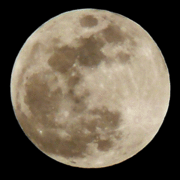Can't fight the moonlight
Recently, a lunar eclipse took place as the Moon passed through some portion of the Earth's shadow. This could only happened when the Sun, Earth and Moon are postioned exactly, or very nearly so, with the Earth in the middle of the two.
A lunar eclipse happens at least twice a year, whenever some portion of the Earth's shadow falls upon the Moon. The Moon will always be full during a lunar eclipse; that is, from the perspective of the Sun, the Moon will be directly behind the Earth. As a consequence, the Moon is always full during a lunar eclipse.
The shadow of the Earth can be divided into two distinctive parts: the umbra and penumbra. Within the umbra, there is no direct solar radiation. However, as a result of the Sun's large angular size, solar illumination is only partially blocked in the outer portion of the Earth's shadow, hence the name, penumbra.
A partial lunar eclipse occurs when only a portion of the Moon enters the umbra. When the Moon travels completely into the Earth's umbra, one observes a total lunar eclipse.
Unlike solar eclipses, lunar eclipses are perfectly safe to see with the naked eye. Below is the last lunar eclipse in 2007 taken from Wikpedia's site:



0 Comments:
Post a Comment
Subscribe to Post Comments [Atom]
<< Home